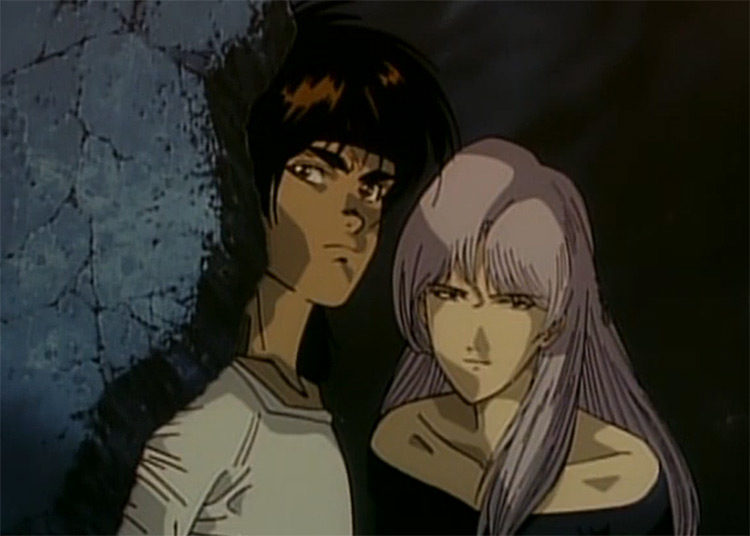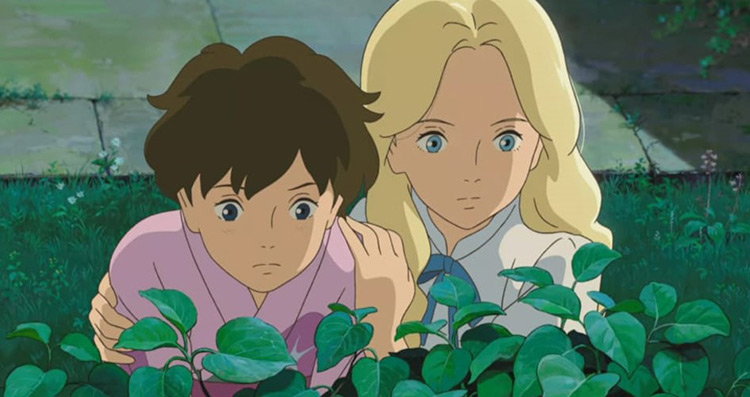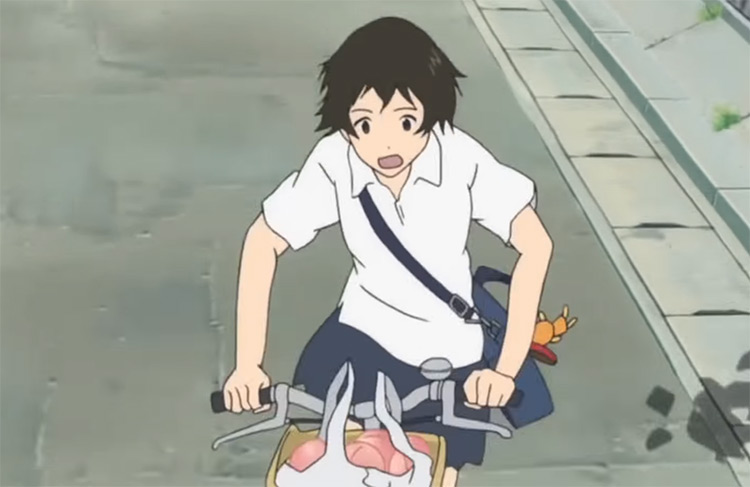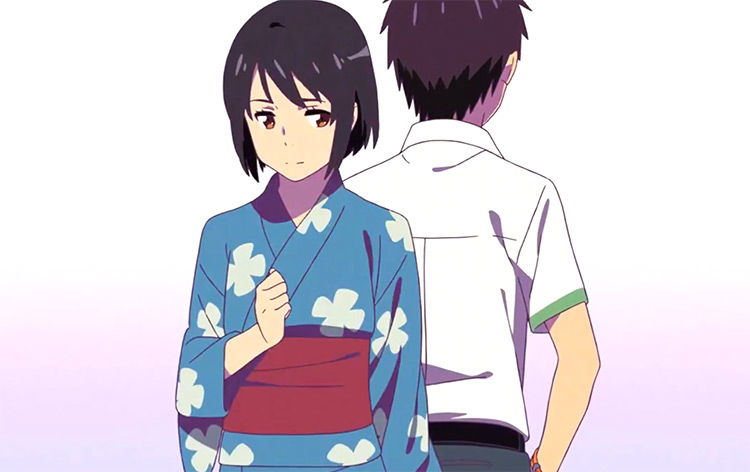15 Most Comfy Anime Movies To Check Out
This post may contain affiliate links. If you buy something we may get a small commission at no extra cost to you. (Learn more).
Perhaps it’s the enclosed nature of films, or maybe its just the way we think about them… but doesn’t it seem like a tightly written film can feel more entertaining than a whole series?
Guess it depends what you like. And anime films might not always be what we think of when we sit down for something to watch.
But if there’s one thing anime does well, it’s a feeling of being comfy.
From your typical children’s anime films to your Ghibli classics, every comfy flick you could ever need is listed right here.
15. Doraemon: Nobita and the Tin Labyrinth

Followers of anime news might have seen that 4Kids is doing a new English dub of Doraemon, which will no doubt be localized into the ground.
Because apparently Americans don’t understand chopsticks.
But don’t be fooled by its late entrance into the Western market. Doraemon has been a long running manga, anime, and film series since 1969.
Nobita and the Tin Labyrinth is the 14th full-length feature Doraemon film. Released in 1994, the film sees the series usual cast travel to a mysterious hotel run by robots. Later on it’s discovered that the hotel is a façade for a secret lab for a humanoid alien species that lost their ability to do things physically due to overreliance on their robot slaves… it’s deep.
Think Wall-E but in 1994.
The film isn’t necessarily any better or more special than the other hundred Doraemon films. But I remember falling asleep watching it as a ten-year-old and getting sleep paralysis.
It. Freaks. You. Out. In a comfy kinda way.
14. ‘Mobile Suit Gundam’ Trilogy

Ok so not a film – but three.
Three that work so well together.
Believe it or not, the original Gundam series was actually a massive flop.
It was close to being cancelled and was actually shortened due to a low ratings. However, things started to change when Bandai bought the series and introduced a toy line based on the giant fighting robots.
In 1981, after the series had started regaining a bit of traction, Bandai took the original series material (which was criticized for being too long and convoluted) and condensed it into three theatrical releases.
These three films were masterpieces of narrative storytelling.
There was never too much action, but never too little. You got to see the characters grow over time but never felt ‘stuck’ with anyone.
Watching the three films is like watching a Shakespearean drama or a grand Space Opera. You’re spoken to, but you’re also there. You’re immersed, but you can escape.
The difference, of course, is that Gundam is about giant fighting robots. Not teenagers falling in love and killing each other (but there’s plenty of that too!)
13. A Wind Named Amnesia

Full disclosure, probably not the most comfy film on here. But nowhere as extreme as ‘End of Evangelion’.
A Wind Named Amnesia is set in a post-apocalyptic world where a mysterious wind has caused most of the world to lose their memories. Even to the point of being unable to speak.
Without memory of anything at all, civilization falls apart at the seams.
Wataru, the main character, is reminded how to speak by a man named Johnny. He was part of a government experiment to increase human memory back.
Having regained the ability to be civilize, Wataru explores the new world alone in his ability to think – until he meets Sophia, a mysterious woman who can speak. Want to know more? Watch the film! It’s really a good one.
12. Interstella 5555: The 5tory of the 5ecret 5tar 5ystem

Imagine if Stephen Spielberg got convinced to direct a full 2 hour sci-fi movie with no speech, only music.
And that the whole movie was a reimagining of Maroon Five’s “Hands All Over”.
Well that’s essentially what happened in 2003 when legendary anime director Leiji Matsumoto of Toei Animation created Interstella 5555, a full-length anime film that uses only the music of Daft Punk’s ‘Discovery’.
The plot is even weirder than the context: an alien band gets kidnapped by an intergalactic military force and bought to Earth where their captor Earl de Darkwood (hint: he’s the bad guy) changes their skin colour to look like Earthlings.
Darkwood then brainwashes the band and makes them play for him.
If you like weird stuff and Daft Punk, watch this.
If you don’t, still watch it. Because credit where it’s due, it’s damn good.
11. Galaxy Express 999

Leiji Matsumoto is known for his sci-fi Space Operas.
Interstella might have been a weird production, but it was not really at all out of character.
The spiritual predecessor and much more successful older brother to Interstella is Galaxy Express 999, a 70s anime classic with fighting robots, spaceships, tragic young heroes, damsels in distress and that unmistakable jazzy-orchestral soundtrack.
Galaxy Express 999 takes place in the far future where humans have achieved space travel and immortality by fusing themselves with robots.
Tetsuo, a ten-year-old living in poverty, wishes to achieve immortality but the surgery is prohibitively expensive on Earth but rumours tell that they’re free in the Andromeda galaxy.
Long story short, he’s given a free pass by a beautiful but mysterious woman Maetel to ride on the Galaxy Express 999: a train that only comes to Earth calling final stop at Andromeda.
10. Fireworks (Should we see it from the side or the bottom?)

An anime adaptation of the 1995 film of the same name, Fireworks is a time travelling, alternative universe romance with super impressive colors and an unbeatable soundtrack.
Norimichi and Nazuna are friends (and crushes) living in the seaside town of Moshimo, set just before a fireworks festival.
They debate whether fireworks look better from the side or from the bottom.
As with all artsy films, this is a metaphor for life. But I’ll let you watch and figure out what that means.
9. In This Corner of the World

Suzu is a young woman who lives in the seaside town of Eba in Hiroshima City.
She gets married at the beginning of the film and moves to Kure, a major naval port 15 miles from Hiroshima. Originally, she loved living in Kure and would watch the warships go in and out of the harbor every day.
But as the war turns against Imperial Japan, Suzu loses her livelihood, loved ones, and even her right hand. She wishes to return to Hiroshima but … we know how this ends.
A movie that tugs at your heartstrings, reminds you of the horrors of war, but somehow still ends with a bittersweet ending.
8. My Neighbour the Yamadas

Takahata is an interesting director.
As Miyazaki’s right hand man, Tanaka’s film style is hard to pin down. But you’ve certainly seen, and are probably a fan, of some of his Ghibli films which include Grave of the Fireflies, Only Yesterday, and Princess Kaguya.
It also includes ‘My Neighbour the Yamadas’ which artistically looks barely anything like those I’ve just listed (maybe except Kaguya).
The film is serial in nature with the 104 minute film being really a series of short skits. Sort of like the kind you see in Nichijou, Lucky Star, or since this is also quite a classic reference, Chibi Maruko-chan.
Also an apt reference because ‘The Yamadas’ is based on simply exploring everyday life as a Japanese family. Despite all your family’s flaws, your family loves you and that’s all you really need in life.
7. When Marnie Was There

Japanese films are often coming of age films featuring young characters who fight against immeasurable odds.
But they can also be comforting films where our heroes find themselves through love and friendship.
When Marnie was There is the latter, but also a bit of a ghost film. And a bit of a dream.
Our young hero is Anna who lives with foster parents. After a strong asthma attack, on recommendation from a doctor, her foster parents drop her off in a seaside town in Hokkaido where the air is clean, and life is relaxing.
However, Anna notices an abandoned mansion across the salt flats and finds out that it was once used as a holiday home for foreigners… but that it is rarely visited anymore.
Then Marnie appears, a blond-haired girl just slightly older than Anna. Despite having never met, they immediately feel a connection. Possibly one that goes back generations.
6. Kiki’s Delivery Service

Fun Fact: Kiki was one of the first anime films to be dubbed into English and absolutely the first Ghibli film to be dubbed (Ghibli and Disney had just signed a 15 year deal).
The English version was released in 1998 in Seattle, but the original Japanese version was out in 1989.
It’s a heart warming film now known the world over by now. Kiki’s Delivery Service is a coming of age movie about Kiki, a young witch, who travels away from home to practice her skills. As is the tradition for witches her age.
She sets herself up in the port town of Koriko and begins working with a local baker as flying delivery service.
Go (re)watch the film and return to a simpler time when boys built bikes that flew and girls rode little brooms. And if you haven’t seen it yet, definitely check it out. This one’s real comfy.
5. The Girl Who Leapt Through Time

Ever wish you could hop back in time? Maybe to prolong a fun moment, maybe to not be late for school… or more time to finish your work.
At what point would you realize that changing your own time stream can cause chaos for others?
These are the questions that ‘The Girl Who Leapt Through Time’ tries to answer.
Makoto, a student in Tokyo, finds a walnut shaped object that lets her jump back in time.
She originally does it for her own benefit. But finds out that she only has a limited number of jumps and has caused a lot of chaos with her non-stop time travel.
With only a few hops left, Makoto has to fix everything. But will she be able to?
4. Laputa: Castle in the Sky

Here’s a personal classic, but one that I think no one can argue with.
One of Miyazaki’s greatest film, Laputa is a loose retelling of Jonathan Swift’s 1887 classic ‘Gulliver’s Travels’ focused only on aristocratic floating society of Laputa.
In the Ghibli version, Laputa is a thing of the past. Nature has reclaimed their once proud city and the people have integrated with society on the ground.
The hand painted art of Laputa is beyond stunning. Even by Ghibli standards.
And the soundtrack has some of the most memorable tunes in anime history.
3. The Garden of Words

Directed by master Makoto Shinkai, Garden of Words is a story of impossible friendship, love soaked in poetry, novel coloring techniques, and the rain.
Takao is a fifteen-year-old student who skips school to design shoes in Shinjuku National Park in Central Tokyo.
Yukari is a lonely and elusive twenty-seven-year-old who skips work to hang out in the park.
From the start, there’s an immeasurable loneliness between the two. And soon, only meeting on rainy mornings in the gardens, their friendship blossoms into the stories told in this incredibly memorable film.
2. Your Name

The Garden of Words was successful for Shinkai. But the success was nowhere near what would happen three years later when he directed ‘Your Name’, the highest grossing anime movie of all time.
Taki and Mitsuha are a boy and girl living on different sides of society.
Taki lives in central Tokyo and Mitsuha lives on the mountains of Hida prefecture.
One day, Mitsuha wishes that she could be a handsome boy in her next life and wakes up in Taki’s body.
They communicate to each other by leaving notes, texts, and even by writing on each other’s bodies. Weird right? Despite never meeting in person, they form a close bond (literally becoming each other also helps!)
One day after a festival, the communications between the two stop. And Taki starts to forget Mitsuha’s life… how is this possible?
Take that intrigue and go check it out. You won’t be disappointed.
1. Whisper of the Heart

Whisper of the Heart is not the most exciting film in the Ghibli collection.
It’s in fact noticeable for not even being a Miyazaki film. It’s not even a Takahata film, it’s actually the only one directed by Yoshifumi Kondo. He was head of animation on several of Miyazki’s big projects including Kiki.
Maybe it’s the realism of the plot, maybe it’s the approachable and wholesome characters. Or perhaps it’s the amazing soundtrack which includes the famous Japanese cover of Take Me Home, Country Roads, a song that appears many times throughout the film.
Whatever the reason is, the movie is one of the studio’s most relaxing.
It’s a warm hug. A reminder of an infinite childhood and a pat on the back.
It was also Kondo’s only film because only a few years after directing it, he would pass away. Soon after Miyazaki would announce his first retirement. Though, as history shows, he would return and deliver many other films that we cherish to this day.






